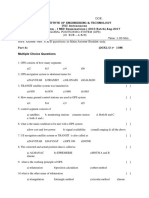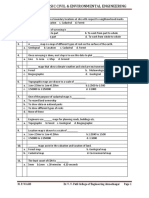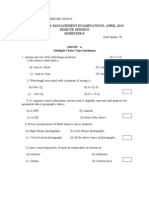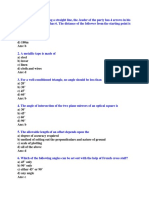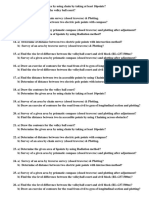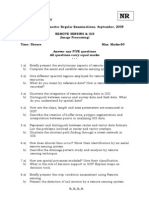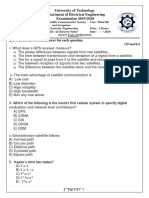100%(1)100% found this document useful (1 vote)
Global Positioning System Fill in The Blanks Unit I: Introduction
Global Positioning System Fill in The Blanks Unit I: Introduction
Uploaded by
Honey Durga TiwariThe document provides information about the Global Positioning System (GPS) in the form of multiple choice and fill in the blank questions across five units. Some key details include:
- GPS is a satellite system that uses 24 satellites in 16 orbits to provide location and time information to GPS receivers.
- The three segments of the GPS system are the space segment (satellites), control segment (ground stations), and user segment (receivers).
- GPS signals use binary phase shift keying modulation and atomic clocks to keep precise time on the satellites. Receivers need measurements from at least 3 satellites to determine position.
- Differential GPS can improve accuracy by using corrections from a fixed reference station. Applications include
Copyright:
© All Rights Reserved
Available Formats
Download as DOCX, PDF, TXT or read online from Scribd
Download as docx, pdf, or txt
Global Positioning System Fill in The Blanks Unit I: Introduction
Global Positioning System Fill in The Blanks Unit I: Introduction
Uploaded by
Honey Durga Tiwari100%(1)100% found this document useful (1 vote)
The document provides information about the Global Positioning System (GPS) in the form of multiple choice and fill in the blank questions across five units. Some key details include:
- GPS is a satellite system that uses 24 satellites in 16 orbits to provide location and time information to GPS receivers.
- The three segments of the GPS system are the space segment (satellites), control segment (ground stations), and user segment (receivers).
- GPS signals use binary phase shift keying modulation and atomic clocks to keep precise time on the satellites. Receivers need measurements from at least 3 satellites to determine position.
- Differential GPS can improve accuracy by using corrections from a fixed reference station. Applications include
Original Description:
GPS objective questions
Original Title
gps_objective_questions_all_units
Copyright
© © All Rights Reserved
Available Formats
DOCX, PDF, TXT or read online from Scribd
Share this document
Did you find this document useful?
Is this content inappropriate?
The document provides information about the Global Positioning System (GPS) in the form of multiple choice and fill in the blank questions across five units. Some key details include:
- GPS is a satellite system that uses 24 satellites in 16 orbits to provide location and time information to GPS receivers.
- The three segments of the GPS system are the space segment (satellites), control segment (ground stations), and user segment (receivers).
- GPS signals use binary phase shift keying modulation and atomic clocks to keep precise time on the satellites. Receivers need measurements from at least 3 satellites to determine position.
- Differential GPS can improve accuracy by using corrections from a fixed reference station. Applications include
Copyright:
© All Rights Reserved
Available Formats
Download as DOCX, PDF, TXT or read online from Scribd
Download as docx, pdf, or txt
100%(1)100% found this document useful (1 vote)
Global Positioning System Fill in The Blanks Unit I: Introduction
Global Positioning System Fill in The Blanks Unit I: Introduction
Uploaded by
Honey Durga TiwariThe document provides information about the Global Positioning System (GPS) in the form of multiple choice and fill in the blank questions across five units. Some key details include:
- GPS is a satellite system that uses 24 satellites in 16 orbits to provide location and time information to GPS receivers.
- The three segments of the GPS system are the space segment (satellites), control segment (ground stations), and user segment (receivers).
- GPS signals use binary phase shift keying modulation and atomic clocks to keep precise time on the satellites. Receivers need measurements from at least 3 satellites to determine position.
- Differential GPS can improve accuracy by using corrections from a fixed reference station. Applications include
Copyright:
© All Rights Reserved
Available Formats
Download as DOCX, PDF, TXT or read online from Scribd
Download as docx, pdf, or txt
You are on page 1/ 15
Global Positioning System
Fill in the Blanks
Unit I: Introduction
Q.01 Global Positioning System (GPS) is a __________
(Ans: satellite system)
Q.02 Global Positioning Service (GPS) uses 24 satellites in __________
(Ans: l6 orbits)
Q.03 GPS means __________
(Ans: Global Positioning System)
Q.04 __________ use GPS to verify the roads
(Ans: Mapmarkers)
Q.05 How many GPS Satellites are currently in orbit around the earth?
(Ans: 24)
Q.06 How close to your actual position can a GPS receiver measure?
(Ans: Within 1 m)
Q.07 The three segments of the GPS system are the space segment, the user segment and the
__________ segment.
(Ans: control segment)
Q.08 What are the clocks called that are used by GPS satellites to very accurately keep time?
(Ans: Atomic Clock)
Q.09 How many measurements (minimum) must be made to give us an accurate estimation
of our position on the earth?
(Ans: 3)
Q.10 What does GIS stand for?
(Ans: Geographic Information System)
UNIT II: Signal Characteristics
Q.01 The intentional degradation of GPS signal in specific areas is called __________ .
(Ans: selective availability)
Q.02 What is the number of GPS satellites used?
(Ans: 24)
Q.03 __________ type of modulation is used in L1 Signal of the GPS
(Ans: Binary phase shift keying)
Q.04 __________ is the reason for sending two transmissions in the same band
(Ans: Ionosphere refraction corrections)
Q.05 The clock used in GPS will synchronize to __________
(Ans: UTC (Co-ordinated Universal Time))
Q.06 __________ carries the encrypted precise code
(Ans: L2 signal)
Q.07 What are the clocks called that are used by GPS satellites to very accurately keep time ?
(Ans: Atomic clocks)
Q.08 The loss of signal is accounted for by a quantity called the __________
(Ans: free-space loss factor (FSLF))
Q.09 __________ is a technique in which each channel transmits its bits as a coded channel-
specific sequence of pulses.
(Ans: Code Division Multiplexing (CDM))
Q.10 Carrier Phase is based on the principle of _______ where the phase measurement is
done.
(Ans: EDM (Electronic Distance measurement))
Q.11 GPS receiver calculates distance between __________ in order to generate position
data.
(Ans: satelites and receiver)
Q.12 Which is known as Gold code?
(Ans: Pseudorandom code)
UNIT III: GPS Receivers and Data Errors
Q.01 __________ also known as 'GPS mice'.
(Ans: Not-self-contained receivers)
Q.02 __________ is one of the major sources of errors, which harms GPS signals.
(Ans: Multipath)
Q.03 Selective Availability (SA) consists of two different components __________,
__________.
(Ans: Dither,Epsilon)
Q.04 __________ is the process performed by the front end to lower the RF signal frequency
to either an intermediate frequency or directly to baseband.
(Ans: Down-conversion)
Q.05 __________ (also called substrates) do not include a (LNA) Low Noise Amplifier.
(Ans: Passive antennas)
Q.06 The two primary layers of the atmosphere, namely __________, __________.
(Ans: ionosphere and troposphere)
Q.07 __________ results in cycle slips and are detected and reduced at the time of processing
of data.
(Ans: Multipath Effects)
Q.08 __________ is a value with which position and velocity of a satellite at any time can be
determined.
(Ans: Ephemeris)
Q.09 __________ clock contains quartz crystals.
(Ans: Receiver)
UNIT IV: Differential GPS
Q.01 Instead of conventional Kalman filtering __________ can be used
(Ans: I Schmidt-Kalman filtering)
Q.02 __________ is used to predict performance of a Kalman filter.
(Ans: Riccati equation)
Q.03 The process of predicting the performance of Kalman filter is called covariance analysis
__________
(Ans: covariance analysis)
Q.04 The primary mission of WAAS is to provide a means for air navigation for all phases of
flight in the __________
(Ans: National Airspace System (NAS))
Q.05 What is used to support the transfer of files, perform remotely initiated software
configuration checks and accept requests to start and stop execution of the C&V application
software?
(Ans: Control C&V Operations and Maintenance (COM))
Q.06 __________ has to be employed to ensure the integrity of GPS data and their
corrections in the WAAS messages broadcast
(Ans: Independent Data Verification and Validation (IDV&V))
Q.07 WAAS has a/an __________ used for early development test.
(Ans: Functional Verification System (FVS))
Q.08 What are the two parameters added to the system state vector?
(Ans: Wheel Speed Scale Factor and Compass Bias)
Q.09 __________ transmits messages containing independently verified results of C&V
calculations to the GUS processing (GP) for broadcast.
(Ans: Message Output Processing (MOP))
Q.10 __________ is the ability to provide timely warnings to the user whenever any
navigation parameters estimated using the system are outside tolerance limits.
(Ans: Integrity)
Q.11 A least-squares estimate from the linear pseudorange differential is developed to obtain
the __________
(Ans: GDOP (geometric dilution of precision))
Q.12 The resulting Kalman filter implementation is __________ nonlinear.
(Ans: doubly)
Q.13 GDOP will be calculated to determine the __________of the ground stations with
respect to fixed satellites.
(Ans: optimal locations)
UNIT V: GPS Applications
Q.01 GIS stands for __________
(Ans: Geographic Information System)
Q.02 Which type of data is collected by the GPS?
(Ans: Spatial data)
Q.03 Which type of analytics recommends decisions using optimization, simulation etc.
__________
(Ans: Prescriptive)
Q.04 The device which converts physical ·phenomenon into electrical signal is known as
__________
(Ans: sensor)
Q.05 The vehicle routing problem that allows the service to be extended over M days, instead
of a single-day service is known as __________
(Ans: Periodic Vehicle Routing Problem (PVRP))
Q.06 Which component of GPS system consists of five ground stations -located around the
world that makes sure the satellites are working properly? __________
(Ans: The control segment)
Q.07 In RFID system, EPC code is able to identify upto __________ items uniquely.
(Ans: 2^96)
Q.08 GPS surveying provides __________ control points.
(Ans: three dimensional)
Q.09 The standard for GPS surveying is designated in terms of __________ of the average of
the set of squared differences between data set coordinate values and the true or theoretical
location of the point obtained preferably from an independent source of higher accuracy.
(Ans: root mean square error)
Q.10 Least square method for GPS network adjustment consists of __________ broad steps.
(Ans: 3)
Multiple choice questions
Unit I: Introduction
Q.01 Which of the following position services provided by the GPS require crypto keys?
[a] Precise position service
[b] Standard position service
[c] Ultimate position service
[d] Doppler position service
(Ans: a)
Q.02 What type of modulation is used in L1 Signal of the GPS?
[a] Amplitude modulation
[b] Phase modulation
[c] Frequency shift keying
[d] Binary phase shift keying
(Ans: d)
Q.03 What type of antenna is used in GPS systems?
[a] Yagi antenna
[b] Helical array antenna
[c] Loop antenna
[d] Parabolic antenna
(Ans: b)
Q.04 Airplane and boat pilots use GPS for
[a] mapping
[b] limit setting in air or water
[c] navigation
[d] bearing
(Ans: a)
Q.05 How does a GPS receiver determine from which satellites it is receiving the signal?
[a] Each satellite uses its own frequency.
[b] The signals are sent on the same frequency and coded.
[c] Each satellite sends its signals at different times.
[d] The signals are sent on different frequencies and coded. '
(Ans: b)
Q.06 Which of the following is not an error of GPS?
[a] Ephemeris error.
[b] Geometric dilution of position
[c] Clock error
[d] Tropospheric ducting
(Ans: b)
Q.07 Which of the following is incorrect about the coarse acquisition code of GPS signals?
[a] It is transmitted 90 degrees out of phase from the precision code.
[b] It contains the PRN of each individual satellite.
[c] It allows an accuracy of ± 30 m on 99 % of occasions.
[d] It is encrypted for US military use.
(Ans: a)
Q.08 What does a GPS receiver measure to compute its position?
[a] The ranges from the satellites.
[b] The difference in time from signal transmission to reception,
[c] The doppler difference in signal speed from transmission to reception.
[d] The difference between the satellite clock and the receiver clock.
(Ans: b)
Q.09 NAVSTAR/GPS operates in the band and the receiver determines position by
[a] UHF, range position lines
[b] UHF, secondary radar principles
[c] SHF, secondary radar principles
[d] SHF, range position lines
(Ans: a)
Q.10 The NAVSTAR / GPS control segment comprises
[a] the space segment, the user segment and the ground segment
[b] a ground segment and the INMARSAT geostationary satellites
[c] a master control station, a back-up control station and five monitoring stations
[d] a master control station, a back-up control station and five monitoring stations and the
INMARSAT geostationary satellites
(Ans: c)
UNIT II: Signal Characteristics
Q.01 Which among the following can be described as an application of pseudo ranging?
[a] Computation of distance between satellite and user
[b] Computation of distance between GPS antenna and satellite
[c] Computation of distance between GPS antenna and user
[d] Computation of distance between satellite and object
(Ans: b)
Q.02 Which of the following is not used in the tracking system?
[a] Multiple frequency
[b] Single frequency
[c] Military navigation
[d] Dual frequency
(Ans: a)
Q.03 Which of the following is having same principle as that of determining the position in
GPS?
[a] Compass
[b] Trisection
[c] Traversing
[d] Resection
(Ans: d)
Q.04 Which is the main parameter used in pseudo ranging?
[a] Time
[b] Velocity
[c] Distance
[d] Frequency
(Ans: a)
Q.05 Satellite generates which type of signals?
[a] Visible rays
[b] Cosmic waves
[c] X-rays
[d] Radio waves
(Ans: d)
Q.06 Which of the following indicates the principle of GPS?
[a] Resection
[b] Trisection
[c] Trilateration
[d] Traversing
(Ans: b)
Q.07 Which of the following can indicate the correct set of GPS segments?
[a] Navigation, space
[b] User, navigation
[c] Control, user
[d] Control, navigation
(Ans: c)
Q.08 Which of the following can be identified as the correct setfor position fixing method?
[a] Carrier phase, relative positioning
[b] Code phase, absolute positioning
[c] Absolute positioning, relative positioning
[d] Cod phase, carrier phase
(Ans: d)
UNIT III: GPS Receivers and Data Errors
Q.01 Which of the following is not a category of error?
[a] Change in format
[b] Areal cover
[c] Map scale
[d] Density of observation
(Ans: a)
Q.02 Which of the following acts as a source of inaccuracy?
[a] Format of data
[b] Silver polygon
[c] Unclosed polygon
[d] Dongle nodes
(Ans: a)
Q.03 The accuracy speed of the GPS depends on
[a] Reflection of signal
[b] Signal blockage
[c] Refraction of signal
[d] Position of satellite
(Ans: b)
Q.04 Cycle slip occurs due to change in
[a] wave length
[b] phase
[c] frequency
[d] velocity
(Ans: b)
Q.05 Base receiver is kept stationary in which of the following operations?
[a] Stop-and-go positioning
[b] Kinematic positioning
[c] Fast static positioning
[d] Static positioning
(Ans: c)
Q.06 Which of the following indicates the correct set of GPS data classification?
[a] Almanac and ephemeris
[b] Ephemeris and user segment
[c] Ephemeris and space segment
[d] Almanac and user segment
(Ans: a)
Q.07 How does a GPS receiver determine from which satellites it is receiving the signal?
[a] Each satellite uses its own frequency.
[b] The signals are sen, t on the same frequency and coded.
[c] Each satellite sends its signals at different times.
[d] The signals are sent on different frequencies and coded.
(Ans: b)
Q.08 Which of the following is not an error of GPS?
[a] Ephemeris error.
[b] Geometric dilution of position.
[c] Clock error.
[d] Tropospheric ducting.
(Ans: d)
Q.09 What does a GPS receiver measure?
[a] The time between transmission and reception of a signal from 'a satellite.
[b] The time for a signal to pass from it to the satellite and return.
[c] The time between reception of signals from two satellites.
[d] The phase difference between signals from two satellites.
(Ans: a)
Q.10 Which of the following is incorrect about the coarse acquisition code of GPS signals ?
[a] It is transmitted 90 degrees out of phase from the precision code.
[b] It contains the PRN of each individual satellite.
[c] It allows an accuracy of ± 30 m on 99 % of occasions.
[d] It is encrypted for US military use.
(Ans: a)
Q.11 What does a GPS receiver measure to compute its position?
[a] The ranges from the satellites.
[b] The difference in time from signal transmission to reception.
[c] The doppler difference in signal speed from transmission to reception.
[d] The difference between the satellite clock and the receiver clock.
(Ans: b)
UNIT IV: Differential GPS
Q.01 DGPS is __________
[a] a means for using GPS in your personal computer
[b] a USCG program to use GPS to provide improved position accuracy
[c] a scheme time phase (tp) provide GPS data in a digital format
[d] a scheme to find GPS time
(Ans: b)
Q.02 __________ does DGPS not reduce?
[a] Ionospheric group delay
[b] Multi-path errors
[c] Selective availability
[d] Satellite position errors
(Ans: b)
Q.03 __________ is a form of DGPS in which the user’s GPS receiver receives real-time
pseudorange.
[a] LAOGPS
[b] WAOGPS
[c] WAAS
[d] GUS
(Ans: a)
Q.04 __________ is incorrect about differential GPS
[a] It reduces the effect of selective availability
[b] It reduces ionospheric error
[c] It reduces geometric dilution of position
[d] It increases accuracy
(Ans: c)
Q.05 The use of LAAS and WAAS remove the errors caused by __________
[a] propagation, selective availability, satellite ephemeris and clock.
[b] selective availability, satellite ephemeris and clock.
[c] GDOP/ selective availability and propagation.
[d] receiver clock, GOOP/ satellite ephemeris and clock.
(Ans: b)
Q.06 A LAAS requires __________
[a] an accurately surveyed site on the aerodrome and a link through the INMARSAT
geostationary satellites to pass corrections to X/ Y & Z co-ordinates to aircraft.
[b] an accurately surveyed site on the aerodrome and a link through the INMARSAT
geostationary satellites to pass satellite range corrections to aircraft.
[c] an accurately surveyed site on the aerodrome and a system known as a pseudolite to pass
satellite range corrections to aircraft.
[d] an accurately surveyed site on the aerodrome and system known as a pseudolite to pass
corrections to X/ Y & Z co-ordinates to aircraft.
(Ans: d)
Q.07 The GPS satellites are going around the earth in __________ orbital planes?
[a] 6
[b] 9
[c] 8
[d] 7
(Ans: a)
UNIT V: GPS Applications
Q.01 Identical constellation of satellites is available over an observation station in
consecutive day also __________ but minutes earlier than the previous day.
[a] 4
[b] 3
[c] 1
[d] 2
(Ans: a)
Q.02 Data transformation for digital map making consists of
[a] local coordinates to global coordinates
[b] global coordinates to local coordinates
[c] geodetic heights to orthometric heights
[d] orthometric heights to geodetic heights.:
(Ans: b & c)
Q.03 Digital map making data preparation consists of data __________
[a] measurement
[b] transformation
[c] manipulation
[d] reduction
(Ans: b & d)
Q.04 Civil signal which provides least accurate position is
[a] C/A
[b] L2
[c] L2C
[d] L5
(Ans: a)
Q.05 Types of control stations for engineering surveying are __________
[a] 4
[b] 3
[c] 2
[d] 1
(Ans: b)
Q.06 Control stations is obtained through __________
[a] astronomical observations
[b] GPS surveying
[c] total station
[d] conventional method of surveying
(Ans: b)
Q.07 Number of basic principle of surveying is __________
[a] 4
[b] 3
[c] 2
[d] 1
(Ans: c)
Q.08 The most fundamental line of a surveying is __________
[a] horizontal
[b] vertical line
[c] level line
[d] plumb line
(Ans: d)
Q.09 Quality of raw GPS measurements primarily depend on __________
[a] antenna
[b] field software
[c] receiver
[d] instrument set up
(Ans: a)
Q.10 Quality of GPS field data judged from __________,
[1] availability of required pseudo-ranges and phase-observables of all the frequencies of
GPS signal;
[2] lower the signal to noise ratio, better is the quality of signal.
[3] higher is the occurrence and presence of cycle slip, better is the quality of signal.
[4] higher the correlation among different signals, better is the quality of data.
[a] (1) and (2)
[b] (2) and (3)
[c] (3) and (4)
[d] (1) and (4)
(Ans: d)
You might also like
- Harley Davidson Sportster XLH 883 & XLH 1200 (1993-1994) Service and Repair Manual (Part2)83% (6)Harley Davidson Sportster XLH 883 & XLH 1200 (1993-1994) Service and Repair Manual (Part2)130 pages
- CE6304 Surveying 1 Question Bank Download Here75% (4)CE6304 Surveying 1 Question Bank Download Here12 pages
- Civil Engineering-Surveying and Leveling 362 Important MCQ PDF100% (3)Civil Engineering-Surveying and Leveling 362 Important MCQ PDF70 pages
- Wednesday, 3 October 2012: Civil Engineering - Surveying Multiple Choice Questions and Answers100% (1)Wednesday, 3 October 2012: Civil Engineering - Surveying Multiple Choice Questions and Answers17 pages
- Unit I (: Principles of Geographic Information SystemNo ratings yetUnit I (: Principles of Geographic Information System33 pages
- 2013 Cadastral Surveying - Test 1 (MEMO) PDF100% (3)2013 Cadastral Surveying - Test 1 (MEMO) PDF5 pages
- Chapter 2 Satellite Subsystem Multiple Choice Question Bank100% (1)Chapter 2 Satellite Subsystem Multiple Choice Question Bank3 pages
- Aerial Photogrammetry: Presented by Scholar NoNo ratings yetAerial Photogrammetry: Presented by Scholar No34 pages
- Cadastral Survying and Mapping Service Level Iii100% (2)Cadastral Survying and Mapping Service Level Iii42 pages
- 110 TOP MOST SURVEYING Interview Questions and Answers - Civil Engineering Objective Type Questions100% (1)110 TOP MOST SURVEYING Interview Questions and Answers - Civil Engineering Objective Type Questions18 pages
- ACFrOgA5EauarD75jvFcyrabAHOdSMnkkfEGiwgbz6Mj1EJGo5gUwfGBNuAMXifSk5UlTdQZ3YtNYf iwu0XGmdHKaK2lfP p1QTfDUqSPVqjI0BvybAvvIL28eZ2aINo ratings yetACFrOgA5EauarD75jvFcyrabAHOdSMnkkfEGiwgbz6Mj1EJGo5gUwfGBNuAMXifSk5UlTdQZ3YtNYf iwu0XGmdHKaK2lfP p1QTfDUqSPVqjI0BvybAvvIL28eZ2aI22 pages
- MCQ Questions For Surveying With Solution For Engineering StudentsNo ratings yetMCQ Questions For Surveying With Solution For Engineering Students15 pages
- Surveying Diploma Semester - 3 020060305: Unit 1: Introduction and ScaleNo ratings yetSurveying Diploma Semester - 3 020060305: Unit 1: Introduction and Scale51 pages
- How GPS Works: Karan Barua (2K8/EC/644) Kavita Kajla (2K8/EC/646) Kritika Nimesh (2K8/EC/648)No ratings yetHow GPS Works: Karan Barua (2K8/EC/644) Kavita Kajla (2K8/EC/646) Kritika Nimesh (2K8/EC/648)35 pages
- Satellite Geodesy Multiple Choice Coursework QuestionsNo ratings yetSatellite Geodesy Multiple Choice Coursework Questions12 pages
- OpenSAP Byd4 Week 5 Unit 5 Additional ExerciseNo ratings yetOpenSAP Byd4 Week 5 Unit 5 Additional Exercise2 pages
- SAP Omnichannel Point-Of-Sale by GK, Cloud Edition - Cloud 3.0 (5.21.0) - enNo ratings yetSAP Omnichannel Point-Of-Sale by GK, Cloud Edition - Cloud 3.0 (5.21.0) - en1,505 pages
- Stadium - Vision - Operations Guide 4 0No ratings yetStadium - Vision - Operations Guide 4 0303 pages
- The Judensau - A Medieval Anti-Jewish Motif and Its History by Isaiah ShacharNo ratings yetThe Judensau - A Medieval Anti-Jewish Motif and Its History by Isaiah Shachar181 pages
- Harley Davidson Sportster XLH 883 & XLH 1200 (1993-1994) Service and Repair Manual (Part2)Harley Davidson Sportster XLH 883 & XLH 1200 (1993-1994) Service and Repair Manual (Part2)
- Civil Engineering-Surveying and Leveling 362 Important MCQ PDFCivil Engineering-Surveying and Leveling 362 Important MCQ PDF
- Wednesday, 3 October 2012: Civil Engineering - Surveying Multiple Choice Questions and AnswersWednesday, 3 October 2012: Civil Engineering - Surveying Multiple Choice Questions and Answers
- Unit I (: Principles of Geographic Information SystemUnit I (: Principles of Geographic Information System
- Chapter 2 Satellite Subsystem Multiple Choice Question BankChapter 2 Satellite Subsystem Multiple Choice Question Bank
- 110 TOP MOST SURVEYING Interview Questions and Answers - Civil Engineering Objective Type Questions110 TOP MOST SURVEYING Interview Questions and Answers - Civil Engineering Objective Type Questions
- ACFrOgA5EauarD75jvFcyrabAHOdSMnkkfEGiwgbz6Mj1EJGo5gUwfGBNuAMXifSk5UlTdQZ3YtNYf iwu0XGmdHKaK2lfP p1QTfDUqSPVqjI0BvybAvvIL28eZ2aIACFrOgA5EauarD75jvFcyrabAHOdSMnkkfEGiwgbz6Mj1EJGo5gUwfGBNuAMXifSk5UlTdQZ3YtNYf iwu0XGmdHKaK2lfP p1QTfDUqSPVqjI0BvybAvvIL28eZ2aI
- MCQ Questions For Surveying With Solution For Engineering StudentsMCQ Questions For Surveying With Solution For Engineering Students
- Surveying Diploma Semester - 3 020060305: Unit 1: Introduction and ScaleSurveying Diploma Semester - 3 020060305: Unit 1: Introduction and Scale
- How GPS Works: Karan Barua (2K8/EC/644) Kavita Kajla (2K8/EC/646) Kritika Nimesh (2K8/EC/648)How GPS Works: Karan Barua (2K8/EC/644) Kavita Kajla (2K8/EC/646) Kritika Nimesh (2K8/EC/648)
- Satellite Geodesy Multiple Choice Coursework QuestionsSatellite Geodesy Multiple Choice Coursework Questions
- SAP Omnichannel Point-Of-Sale by GK, Cloud Edition - Cloud 3.0 (5.21.0) - enSAP Omnichannel Point-Of-Sale by GK, Cloud Edition - Cloud 3.0 (5.21.0) - en
- The Judensau - A Medieval Anti-Jewish Motif and Its History by Isaiah ShacharThe Judensau - A Medieval Anti-Jewish Motif and Its History by Isaiah Shachar












